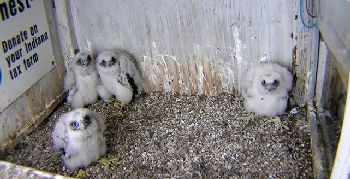 07/13/13 DNR wildlife biologists recently completed banding efforts with a record number of peregrine falcon chicks that were hatched this spring at 15 successful nesting sites across Indiana.
07/13/13 DNR wildlife biologists recently completed banding efforts with a record number of peregrine falcon chicks that were hatched this spring at 15 successful nesting sites across Indiana.
“As a species that is dependent on man-made structures in the lower Midwest, peregrine falcon numbers are at unprecedented levels due to the efforts of many agencies, organizations, companies, and individuals,” said John Castrale, nongame bird biologist with the Indiana DNR Division of Fish & Wildlife. “In return, these spectacular birds give wildlife watchers unique viewing opportunities as they hunt and raise their young in urban and industrial areas.”
DNR biologists monitor peregrine falcon nesting every year, and most young falcons are banded with leg identification tags to help monitor their movements and survival.
The 44 falcon chicks that were banded this year topped the previous high mark of 38 set in 2012. Two additional chicks left their nests this year before biologists could get to them to attach bands.
“Once again, building and plant managers throughout the state were cooperative in allowing access for banding at nest boxes,” Castrale said. “Volunteers were invaluable in monitoring nesting, identifying adults, and keeping young falcons out of harm’s way.”
Nesting sites in East Chicago, Fort Wayne, Indianapolis, Madison, Michigan City and Whiting had the most banded chicks with four each. Three chicks were banded at two sites in Gary and at single nests in Indianapolis, New Albany and Porter County.
Once threatened with extinction in North America, peregrine falcons represent one of the most successful restoration stories in the 40 years of the Endangered Species Act. Their recovery resulted in removal from the federal endangered species list in 1999. A recommendation is pending to remove them from the Indiana list of endangered species.
A half century ago, habitat loss and decreased reproduction resulting from use of pesticides, such as DDT, put peregrine falcons in peril of surviving as a species. By 1965, no peregrine falcons nested east of the Mississippi River, and western populations had declined by 90 percent.
Efforts to study, breed and restore peregrine populations began in the 1970s. Through these efforts, it was discovered that urban settings are successful nesting areas because the skyscrapers mimic the peregrine’s natural cliff-side habitat.
Indiana started its peregrine falcon reintroduction project in 1991, and by 1994 the DNR had released 60 young falcons in Evansville, Fort Wayne, Indianapolis and South Bend.
The number of nesting pairs in the state has slowly increased. Nests are located on buildings, under bridges, and on smokestacks along the Lake Michigan shoreline, at power plants, and in major urban areas.














